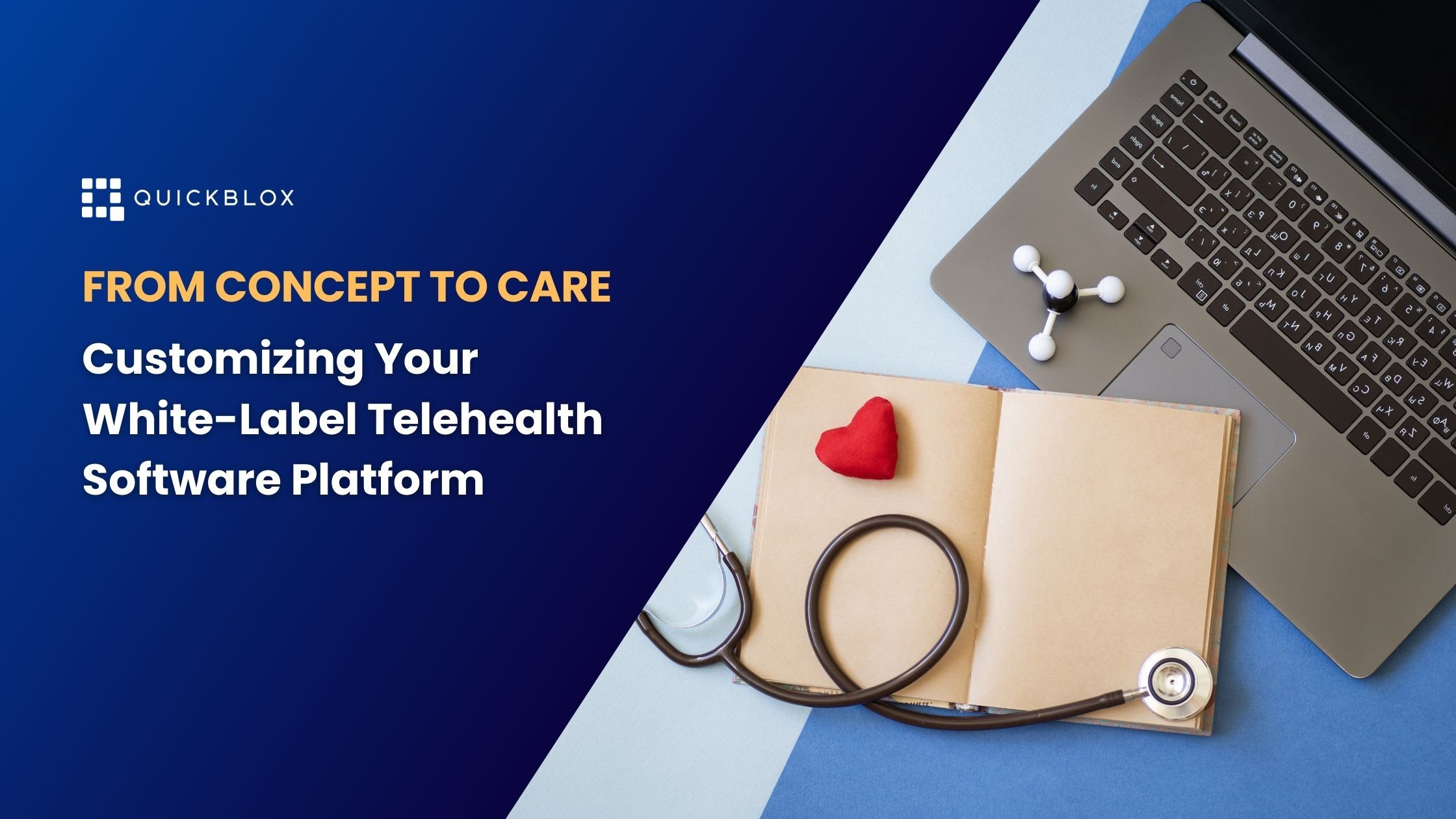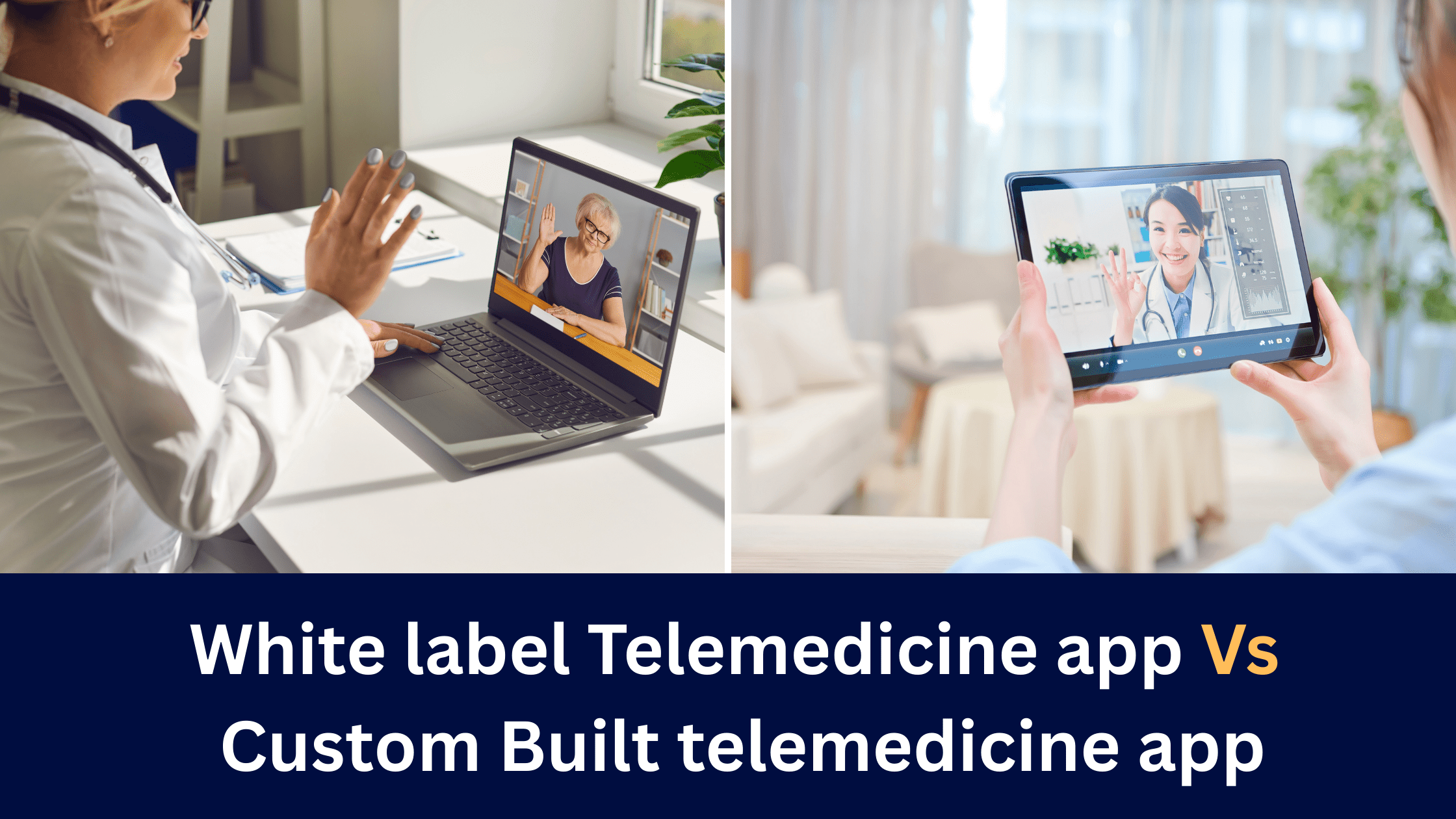
Summary: This article will walk healthcare providers through the process of providing patient care with custom telehealth software. It will outline the advantages of using a white-label solution and the key features that can be customized. It will also provide an overview of the key stages of getting your customized telehealth software platform up and running.
Table of Contents
Introduction
By early 2024, 54% of Americans reported having had at least one telehealth visit—a clear sign that virtual care has become a mainstream part of the healthcare experience. As virtual care becomes a standard component of clinical workflows, healthcare providers are increasingly seeking telehealth solutions that offer not only regulatory compliance but also deep customization. As more patients engage with providers online, expectations for seamless, branded, and user-friendly digital encounters are growing. For healthcare organizations, a white-label telehealth platform to deliver just that—tailored to their unique workflows and visual identity. In this blog, we explore the customizable features that can turn a generic telehealth app into a polished extension of your brand, from branded URLs to personalized virtual waiting rooms.
From Concept to Strategy: Laying the Groundwork for Customization
So you’ve selected a white-label telehealth platform. Now what? Before jumping into design adjustments and feature enhancements, it’s worth taking the time to create a strategic customization plan that aligns with your objectives, workflows, and patient requirements.
Begin with a Discovery Phase. Ask yourself:
- Who are my users? (Are you serving pediatric patients, older users, mental health professionals, etc.)
- What are some issues I’m assisting them with?
- What would be the ideal custom telehealth software development experience—both for the patient and the provider?
Then, explain the key goals for your site:
- Do you wish to reduce in-person consultations?
- Improve chronic care management?
- Facilitate greater access in rural communities?
- Provide counseling or mental health therapy?
Once your goals have been set, you will have to decide the extent of your solution:
- Will it be mobile-first or web-based?
- Do you need video calling, live chat, scheduling, or integration with EHRs?
- How will you handle various user roles—doctors, admins, nurses, patients?
This planning stage ensures that by the time you finally get to customize, you’re creating a white-label telemedicine software that is really working for your users, is scaling as your business scales, and ticks all the compliance boxes.
Learn more about: How to Leverage White Label Telemedicine to Enhance Your Brand
White-label isn’t one-size-fits-all. One of the best things about a white-label solution is that it can customize the features and functionality to suit your brand and the needs of your users. Let’s consider some of the most crucial places where customization can make an enormous difference:
User Interface (UI) & Branding
First impressions do count. You can totally revamp the visual look and feel of the platform—logos, font, color scheme, layout—to match your brand. This gives a unified experience from your website right through to your white-label telemedicine app.
Branded URLs and Subdomains
One of the key advantages of a white-label telehealth app is the ability to use a custom-branded URL or subdomain that reflects your healthcare organization’s identity. Instead of directing patients to a generic platform domain, you can offer access through something like telehealth.yourclinicname.com. This not only reinforces brand trust and professionalism but also creates a seamless digital experience for your patients from start to finish.
Intake Forms
An increasing number of telehealth platforms are now incorporating AI-powered intake forms to streamline the data collection process before a patient’s consultation begins. These intelligent forms can be fully customized to match the unique needs and workflows of each clinic, improving efficiency and enhancing the patient experience.
Tailored Virtual Waiting Rooms
Customizable virtual waiting rooms allow you to create a branded, patient-friendly space before the consultation begins. You can add your clinic’s logo, colors, welcome message, and even display helpful information or instructions—making the experience more personal and reassuring for patients as they wait to connect with their healthcare provider.
Video & Audio Consultation Modules
Need 1:1 video sessions?
Group therapy rooms?
Asynchronous voice notes?
Most platforms enable you to customize the format and sequence of virtual consultations to fit your model of care.
Scheduling and Reminding for Appointments
Personalize appointment scheduling, rescheduling, and reminders. You can choose calendar integrations, SMS/email reminders, timezone handling, and even automated reminders.
Chat & Messaging Integration
Secure messaging is one aspect of modern custom telehealth software development. Adjust your chat function to include real-time messaging, file sharing, chatbot support, or templated messaging for clinical documentation.
EHR & Third-Party Integrations
Need to integrate with an existing Electronic Health Record system or billing system? White-label telemedicine software solutions have API access or pre-configured connectors in most instances to integrate your technology stack.
User Access Controls & Roles
You can specify how each type of user interacts with the site—doctors, nurses, administrators, and patients can all have different interfaces and permissions.
Security & Privacy Layers
Tailor security features such as two-factor authentication, consent forms, encrypted file storage, and audit logs to remain compliant and gain user trust.
By tailoring these functions, you’re not just branding the application—you’re making it smarter, more secure, and more aligned with your clinical goals.
Back-end Flexibility & Tech Stack: Making It Work for You
Your white-label solution may be pre-configured, but the back-end must always provide you with the flexibility to customize. To have the proper technical flexibility in your solution is to have one where you can scale, integrate, and innovate without any hindrance.
Modular Architecture
Look for a solution made up of modular components. It’s easier to turn features on or off as your platform expands—without rewriting the entire codebase.
API-First Design
An API-first platform allows your developers to integrate third-party services, introduce functionality, or even create custom telehealth software development applications on top of your white-label telehealth platform.
Cloud vs On-Premise Hosting
- Cloud hosting is more adaptable, updates quicker, and scales more smoothly.
- On-premise could be better suited for internally hosted IT or for those companies with very high data residency needs.
Real-Time Communication Tools
Make sure that the platform supports real-time video, audio, and chat through technologies like WebRTC, MQTT, or XMPP—and that these modules are well-documented and simple to deploy.
SDKs & Developer Support
A customizable platform is only as valuable as its documentation. SDKs, sandbox, and an actively engaged dev support team will carry you a long way in empowering your team to code effectively.
Choosing the correct tech stack isn’t really about what’s under the hood—it’s about how well your team can utilize it today and how well it can adapt to support your vision tomorrow.
Learn more about: Top White Label Telemedicine App Consultation Services.
Testing & Compliance: Trust from Day One
Trust is a matter of life and death, particularly in healthcare. Your platform must be tested to perfection—before it’s in the hands of providers and patients.
White-Label Telehealth Platforms Testing Best Practices
To provide performance, security, and usability, consider implementing:
- Functional Testing: Make sure all features act as expected.
- Load Testing: Test real user loads to verify that the platform can sustain traffic.
- Accessibility Testing: Make sure your platform is usable by people with disabilities.
- Security Testing: Identify vulnerabilities before they become threats.
Compliance & Privacy Standards
Depending on your location and your visitors, your website may need to comply with:
- HIPAA (USA) / PIPEDA (Canada) – Safeguards patient health information (PHI).
- GDPR (EU) – Controls data protection and privacy.
- HL7 / FHIR – Healthcare interoperability standards.
- SOC 2, ISO 27001 – Information security and data handling certifications.
Also, ensure that you adopt:
- Informed consent processes
- Data encryption (in transit and at rest)
- User activity logs and audit trails
Compliance is not something to check off a list box—it’s vital to patient safety, platform credibility, and long-term success. Highlighting these upfront can save you the expense of expensive revisions or legal issues later on.
Deployment and Launch: Launching Live with Confidence
You’ve tailored your white-label platform and piloted it—now you’re ready to roll it out. Deploying a custom telehealth software development platform, however, is not as easy as hitting the “publish” button. A thoughtful deployment guarantees a seamless rollout, reduces downtime, and lays the groundwork for sustained success.
Staging Before Production
Start with a staging environment that is similar to your live environment. This allows you to:
- Validate integrations
- Validate user flows with live data
- Perform final security checks
It’s your final practice before the big day.
Soft Launch versus Full Rollout
Soft launch—to a single clinic or pilot user base, for example—is a way you can test, learn, and iron out last-minute issues before opening up the floodgates to the general population. Internal acceptance and adoption ensue.
Training & Onboarding
Equip your care teams with the following:
- Onboarding user guides and tutorials
- Live training sessions or demo videos
- Frequently Asked Question support points and resources
The easier you make it for providers to utilize, the better they’ll utilize it—and the more value your platform will create.
Post-Launch Feedback Loops
Gather feedback early and often. Utilize surveys, in-app feedback, and analytics to monitor:
- Points of drop-off in the user process
- Feature adoption rates
- Support tickets or common problems
Continuous enhancement post-launch is what sets a good white-label telemedicine app to a great one.
Growing with Your Users: Post-Launch Growth & Optimization
A successful launch is only the start. As your users utilize the platform, you’ll discover new needs, wants, and places to grow. The best white-label solutions facilitate this type of iterative growth.
Scale Regionally or Across Specialties
Having laid your foundation, you are now ready to scale
- To new countries or lands
- In some medical specialties
- To finance new modalities like remote diagnostics or home care
Customization doesn’t end after launch—it merely becomes more intentional.
Conclusion
White-label telehealth is revolutionizing healthcare delivery, and white-label platforms have never made it simpler to implement innovative, consumer-friendly solutions without the burden of building from scratch. But the real value comes from tailoring that platform—how you align technology with your mission, brand, workflows, and users’ needs.
At QuickBlox, our white-label solution, Q-Consultation, enables healthcare providers to launch fully branded, HIPAA-compliant telehealth platforms with secure chat, video, and AI-powered features—without building from scratch.
Talk to a sales expert
Learn more about our products and get your questions answered.
Contact sales FAQs
What is white-label telemedicine?
White-label telemedicine is an existing telehealth software platform that can be rebranded and tailored by multiple healthcare organizations or startups to serve their specific use case needs. It includes necessary features like video consultations, messaging, scheduling, and EHR integration—without reinventing the entire thing. You have full control over design, user experience, and functionality at the cost of saving time and development dollars.
Which telehealth platform is used most?
Though use tends to be region-specific, products like Teladoc Health, Amwell, and Doxy.me are the most prevalent used in the U.S. market. Nevertheless, more and more providers now seek white-label solutions that may be tailored to better suit the specific clinical workflows and branding needs of their facilities.
What is white labeling in healthcare?
White labeling in healthcare is the process of acquiring a third-party white-label telemedicine software or product—such as a white-label telehealth platform, patient portal, or EHR system—and reselling it under your own brand. It’s a common strategy for healthcare organizations that need to get up and running quickly, ensure brand consistency, and yet have the ability to customize features and integrations without developing technology internally.
What is an example of a white-label platform?
A white-label example is Q-Consultation by QuickBlox that allows healthcare providers to launch a fully branded, HIPAA-compliant telehealth platform quickly and easily. It provides virtual meeting rooms, chat messaging, video consultation, AI medical assistants, and more.








